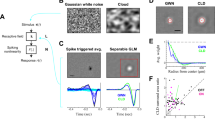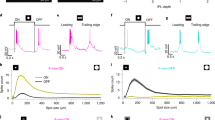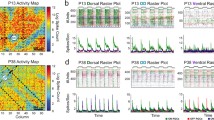Abstract
To gain a deeper understanding of the transmission of visual signals from retina through the lateral geniculate nucleus (LGN), we have used a simple leaky integrate and-fire model to simulate a relay cell in the LGN. The simplicity of the model was motivated by two questions: (1) Can an LGN model that is driven by a retinal spike train recorded as synaptic (‘S’) potentials, but does not include a diverse array of ion channels, nor feedback inputs from the cortex, brainstem, and thalamic reticular nucleus, accurately simulate the LGN discharge on a spike-for-spike basis? (2) Are any special synaptic mechanisms, beyond simple summation of currents, necessary to model experimental recordings? We recorded cat relay cell responses to spatially homogeneous small or large spots, with luminance that was rapidly modulated in a pseudo-random fashion. Model parameters for each cell were optimized with a Simplex algorithm using a short segment of the recording. The model was then tested on a much longer, distinct data set consisting of responses to numerous repetitions of the noisy stimulus. For LGN cells that spiked in response to a sufficiently large fraction of retinal inputs, we found that this simplified model accurately predicted the firing times of LGN discharges. This suggests that modulations of the efficacy of the retino-geniculate synapse by pre-synaptic facilitation or depression are not necessary in order to account for the LGN responses generated by our stimuli, and that post-synaptic summation is sufficient.
Similar content being viewed by others
References
Andolina, I. M., Jones, H. E., Wang, W., & Sillito, A. M. (2007). Corticothalamic feedback enhances stimulus response precision in the visual system. Proceedings of the National Academy of Sciences of the United States of America, 104(5), 1685–1690.
Berry, M. J., Warland, D. K., & Meister, M. (1997). The structure and precision of retinal spike trains. Proceedings of the National Academy of Sciences of the United States of America, 94(10), 5411–5416.
Bishop, P. O. (1953). Synaptic transmission; an analysis of the electrical activity of the lateral geniculate nucleus in the cat after optic nerve stimulation. Proceedings of the Royal Society of London B, Biological Sciences, 141(904), 362–392.
Blitz, D. M., & Regehr, W. G. (2003). Retinogeniculate synaptic properties controlling spike number and timing in relay neurons. Journal of Neurophysiology, 90(4), 2438–2450.
Blitz, D. M., & Regehr, W. G. (2005). Timing and specificity of feed-forward inhibition within the lgn. Neuron, 45(6), 917–928.
Carandini, M., Demb, J. B., Mante, V., Tolhurst, D. J., Dan, Y., Olshausen, B. A., et al. (2005). Do we know what the early visual system does? Journal of Neurophysiology, 25(46), 10577–10597.
Carandini, M., Horton, J. C., & Sincich, L. C. (2006). Postsynaptic mechanisms converting retinal spike trains into geniculate spike trains. Society for Neuroscience Abstracts, 32, 11.14.
Casti, A. R., Omurtag, A., Sornborger, A., Kaplan, E., Knight, B., Victor, J., et al. (2002). A population study of integrate-and-fire-or-burst neurons. Neural Computation, 14(5), 957–986.
Casti, A. R. R., Kaplan, E., Lubliner, K., & Xiao, Y. (2005). Effects of cortical feedback on the lgn: Information transmission and dynamics. Society for Neuroscience Abstracts 31, 506.19.
Chen, C., & Regehr, W. G. (2003). Presynaptic modulation of the retinogeniculate synapse. Journal of Neurophysiology, 23(8), 3130–3135.
Cleland, B. G., Dubin, M. W., & Levick, W. R. (1971). Simultaneous recording of input and output of lateral geniculate neurones. Nature New Biology, 231(23), 191–192.
Cleland, B. G., & Lee, B. B. (1985). A comparison of visual responses of cat lateral geniculate nucleus neurones with those of ganglion cells afferent to them. Journal of Physiology, 369, 249–268.
Destexhe, A. (2000). Modelling corticothalamic feedback and the gating of the thalamus by the cerebral cortex. Journal of Physiology Paris, 94(5-6), 391–410.
Funke, K., Eysel, U. T., & FitzGibbon, T. (1991). Retinogeniculate transmission by NMDA and non-NMDA receptors in the cat. Brain Research, 547(2), 229–238.
Guido, W., Lu, S. M., & Sherman, S. M. (1992). Relative contributions of burst and tonic responses to the receptive field properties of lateral geniculate neurons in the cat. Journal of Neurophysiology, 68(6), 2199–2211.
Hochstein, S., & Shapley, R. M. (1976). Quantitative analysis of retinal ganglion cell classifications. Journal of Physiology, 262(2), 237–264.
Hubel, D. H., & Wiesel, T. N. (1961). Integrative action in the cat’s lateral geniculate body. Journal of Physiology, 155, 385–398.
Jolivet, R., Lewis, T. J., & Gerstner, W. (2004). Generalized integrate-and-fire models of neuronal activity approximate spike trains of a detailed model to a high degree of accuracy. Journal of Neurophysiology, 92(2), 959–976.
Jolivet, R., Rauch, A., Lüscher, H., & Gerstner, W. (2006). Predicting spike timing of neocortical pyramidal neurons by simple threshold models. Journal of Computational Neuroscience, 21(1), 35–49.
Kaplan, E., Purpura, K., & Shapley, R. M. (1987). Contrast affects the transmission of visual information through the mammalian lateral geniculate nucleus. Journal of Physiology, 391, 267–288.
Kaplan, E., & Shapley, R. (1984). The origin of the S (slow) potential in the mammalian lateral geniculate nucleus. Experimental Brain Research, 55(1), 111–116.
Keat, J., Reinagel, P., Reid, R. C., & Meister, M. (2001). Predicting every spike: A model for the responses of visual neurons. Neuron, 30(3), 803–817.
Kistler, W., Gerstner, W., & Hemmen, J. L. V. (1997). Reduction of the Hodgkin–Huxley equations to a single-variable threshold model. Neural Computation, 9, 1015–1045.
Koch, C. (1985). Understanding the intrinsic circuitry of the cat’s lateral geniculate nucleus: electrical properties of the spine-triad arrangement. Proceedings of the Royal Society of London B, Biological Sciences, 225(1240), 365–390.
Kwon, Y. H., Nelson, S. B., Toth, L. J., & Sur, M. (1992). Effect of stimulus contrast and size on NMDA receptor activity in cat lateral geniculate nucleus. Journal of Neurophysiology, 68(1), 182–196.
Levine, M. W., & Cleland, B. G. (2001). An analysis of the effect of retinal ganglion cell impulses upon the firing probability of neurons in the dorsal lateral geniculate nucleus of the cat. Brain Research, 902(2), 244–254.
Liu, R. C., Tzonev, S., Rebrik, S., & Miller, K. D. (2001). Variability and information in a neural code of the cat lateral geniculate nucleus. Journal of Neurophysiology, 86(6), 2789–2806.
Llinás, R., & Jahnsen, H. (1982). Electrophysiology of mammalian thalamic neurones in vitro. Nature, 297(5865), 406–408.
Mastronarde, D. N. (1987). Two classes of single-input X-cells in cat lateral geniculate nucleus. II. Retinal inputs and the generation of receptive-field properties. Journal of Neurophysiology, 57(2), 381–413.
McCormick, D. A., & Huguenard, J. R. (1992). A model of the electrophysiological properties of thalamocortical relay neurons. Journal of Neurophysiology, 68(4), 1384–1400.
Nelder, J. A., & Mead, R. (1965). A simplex method for function minimization. The Computer Journal, 7, 308–313.
Ozaki, T., & Kaplan, E. (2006). Brainstem input modulates globally the transmission through the lateral geniculate nucleus. International Journal of Neuroscience, 116(3), 247–264.
Paninski, L. (2004). Maximum likelihood estimation of cascade point-process neural encoding models. Network, 15(4), 243–262.
Pillow, J. W., Paninski, L., Uzzell, V. J., Simoncelli, E. P., & Chichilnisky, E. J. (2005). Prediction and decoding of retinal ganglion cell responses with a probabilistic spiking model. Journal of Neuroscience, 25(47), 11003–11013.
Press, W. H., Flannery, B. P., Teukolsky, S. A., & Vetterling, W. T. (1992). Numerical Recipes: The Art of Scientific Computing (2nd ed.). Cambridge University Press.
Reid, R. C., Victor, J. D., & Shapley, R. M. (1997). The use of m-sequences in the analysis of visual neurons: linear receptive field properties. Visual Neuroscience, 14(6), 1015–1027.
Reinagel, P., & Reid, R. C. (2000). Temporal coding of visual information in the thalamus. Journal of Neuroscience, 20(14), 5392–5400.
Shelley, M. J., & Tao, L. (2001). Efficient and accurate time-stepping schemes for integrate-and-fire neuronal networks. Journal of Computational Neuroscience, 11(2), 111–119.
Sherman, S. M. (2001). Tonic and burst firing: Dual modes of thalamocortical relay. Trends in Neurosciences, 24(2), 122–126.
Sherman, S. M. (2005). Thalamic relays and cortical functioning. Progress in Brain Research, 149, 107–126.
Sillito, A. M., Murphy, P. C., Salt, T. E., & Moody, C. I. (1990). Dependence of retinogeniculate transmission in cat on NMDA receptors. Journal of Neurophysiology, 63(2), 347–355.
Sincich, L. C., Adams, D. L., Economides, J. R., & Horton, J. C. (2007). Transmission of spike trains at the retinogeniculate synapse. Journal of Neuroscience, 27(10), 2683–2692.
Sirovich, L. (2007). Populations of tightly coupled neurons: The RGC/LGN system. Neural Computation (accepted).
Smith, G. D., Cox, C. L., Sherman, S. M., & Rinzel, J. (2000). Fourier analysis of sinusoidally driven thalamocortical relay neurons and a minimal integrate-and-fire-or-burst model. Journal of Neurophysiology, 83(1), 588–610.
Sutter, E. E. (1987). A practical nonstochastic approach to nonlinear time-domain analysis. In V. Z. Marmarelis (Ed.), Advanced Methods of Physiological Systems Modeling (vol. 1). University of Southern California, Los Angeles.
Troy, J. B., & Robson, J. G. (1992). Steady discharges of x and y retinal ganglion cells of cat under photopic illuminance. Visual Neuroscience, 9(6), 535–553.
Usrey, W. M., Reppas, J. B., & Reid, R. C. (1998). Paired-spike interactions and synaptic efficacy of retinal inputs to the thalamus. Nature, 395(6700), 384–387.
van Hateren, J. H. (1997). Processing of natural time series of intensities by the visual system of the blowfly. Vision Research, 37(23), 3407–3416.
Victor, J. D., & Purpura, K. P. (1996). Nature and precision of temporal coding in visual cortex: A metric-space analysis. Journal of Neurophysiology, 76(2), 1310–1326.
Weyand, T. G. (2007). Retinogeniculate transmission in wakefulness. Journal of Neurophysiology, 98(2), 769–785. Epub 2007 June 6.
Wörgötter, F., & Koch, C. (1991). A detailed model of the primary visual pathway in the cat: Comparison of afferent excitatory and intracortical inhibitory connection schemes for orientation selectivity. Journal of Neuroscience, 11(7), 1959–1979.
Author information
Authors and Affiliations
Corresponding author
Additional information
Action Editor: Matthew Wiener
Rights and permissions
About this article
Cite this article
Casti, A., Hayot, F., Xiao, Y. et al. A simple model of retina-LGN transmission. J Comput Neurosci 24, 235–252 (2008). https://doi.org/10.1007/s10827-007-0053-7
Received:
Revised:
Accepted:
Published:
Issue Date:
DOI: https://doi.org/10.1007/s10827-007-0053-7




